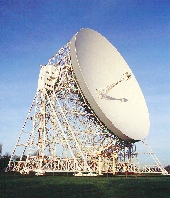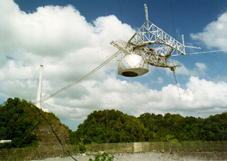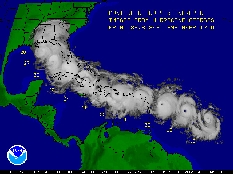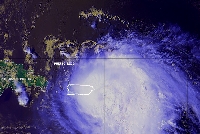
The 76m Lovell Radiotelescope
Photo by Ian Morison

The collaborative research programme with the SETI Institute is part of Project Phoenix which arose out of the ambitious NASA SETI project that had been cancelled by a budget-conscious Congress in 1993. It is entirely supported by private donations and has conducted observations using the Parkes 64m and the Mopra 22m radiotelescopes in Australia as well as the NRAO 140ft radiotelescope in Green Bank, West Virginia.

The 76m Lovell Radiotelescope
Photo by Ian Morison
Jodrell Bank is a world leader in the development of sensitive receivers which are cooled with helium cryogenic systems to 10 - 15 degrees above absolute zero. It is this technology allied to the large collecting area of what is still the second largest fully steerable radiotelescope in the world that has made the Lovell telescope so attractive to project Phoenix. To give you some idea of what this means, the system on the Lovell telescope could detect a mobile phone from a distance of 220 million miles!

The 305m Arecibo Radiotelescope.
Photo by Tony Acevedo
The 305m Arecibo Telescope is operated by the National Astronomy and Ionospheric Centre and has just received a major upgrade to its performance with the introduction of a gregorian secondary reflector system. The SETI Institute installed its signal processing equipment at Arecibo and Jodrell Bank during the summer of 1998.
Previous searches have always been plagued with the problem of discriminating between an extraterrestrial signal and those local to the telescope or from spacecraft in orbit around the earth. Such local signals can be discriminated against by simultaneous observations with two widely separated telescopes. The larger telescope, in this case Arecibo, is using a multi-million channel receiver to make the initial signal detections. Information about those that are not in the data bank of known interference signals are then passed to further specialised receiver systems both at Arecibo and Jodrell Bank. These specifically search for the signal in question which, as a result of the earths' rotation, will have different characteristics at the two observatories. For a signal to be received by both telescopes it has to be at great distance, and as a check the system is regularly used to detect the very weak signals still being transmitted from the Pioneer 6 spacecraft, which orbits the Sun, and Pioneer 10, now far beyond the orbit of Pluto.
The search being undertaken is a "targeted search" looking at specific objects in the sky. These are obviously where you think that it is most likely that such signals might come from, that is, the home of another civilisation. It is believed that other civilisations will most likely be found on planets around stars like our Sun so the search will look at the positions of several hundred such stars within a distance of ~100 light years.
The search is being carried out during two three-week observing sessions each year and will continue for several years. If an extra-terrestrial signal were detected, it would be one of the most dramatic discoveries ever made and we are glad to be making a contribution to this exciting scientific quest.
As scheduled the Project Phoenix SETI observations began early this September. Preparations had taken place during June and July when five of the project team came across from the SETI Institute to unpack and commission the equipment. Members of the RF group here were involved in setting up a complex cabling system which would allow us to switch back and forth between the SETI and Pulsar Systems with ease whilst modems were installed and software written to allow the Lovell Telescope, receiver and detection system to be remotely controlled from Arecibo. There the 305m, newly refurbished, telescope would be used to make initial detections of possible extra-terrestrial signals.
On September 10th the first of the two 20 night observing runs scheduled each year began. The band of frequencies being searched is from 1.2 to 1.8 Ghz and uses our new L-Band receiver, but a second receiver and offset feed operating at S-Band has also been installed to enable test observations to be made of the ~10 watt transmission of the Pioneer 10 spacecraft now 6.5 billion miles from Earth and way beyond the orbit of Pluto. Successful observations of Pioneer 10 were made on the nights of the 10th and 11th and so the real work could begin.
Project Phoenix is carrying out a "targeted search" looking at the places where is appears most likely that another civilisation would be found. Assuming that, like us, life would evolve on the surface of a planet, observations are being made of ~1000 nearby stars like our Sun. Such stars live long enough and provide enough heat to give life a chance to evolve if a suitable planet exists in orbit around it. The target stars are observed for about an hour and a half during which time a multi-million channel receiver at Arecibo steps across the band in 20 Mhz steps with each observation taking around 5 minutes. Many signals are detected in each 5 minute observation and their characteristics are compared with a database of known signals from the earth or satellites in orbit around it. Having eliminated known signals a few are usually left which are then analysed with a second receiver system called a "Follow Up Detection Device" or FUDD. This produces a precise description of the signal which allows a "matched filter" to be produced to gain greater sensitivity.
This information is then passed to an identical FUDD system at Jodrell Bank where the Lovell Telescope is following the same star. Due to the separation between Arecibo and Jodrell the Earth's rotation produces a large relative doppler shift so that, for a signal coming from a great distance, we have to observe around 2 Khz lower in frequency. Thus signals from either the earth ( unlikely to be picked up by both telescopes anyway ) or satellites in orbit around the Earth or Sun should not be detected. Hence the value of Pioneer 10 as a test - almost everything else is too close!
Whilst these follow up observations are being made the Arecibo telescope receivers are searching the next 20 MHz band so a very efficient system results. Only if both follow up systems give a positive detection does the Arecibo dish have to suspend the scan and move off source to see if the signal disappears. This will only have to happen if the FUDD at Jodrell has, by chance, detected another signal at just the right frequency. Interference signals will usually remain and the search continues. If the Lovell Telescope was not being used then the Arecibo dish would have to carry out many such moves to eliminate unwanted signals. This would make the search very inefficient. It would also be far less sensitive as the detection thresholds would have to be set much higher to greatly reduce the number of false alarms.
Thus by using the Arecibo and Lovell telescopes together it is possible to produce a detection system perhaps 40 times more sensitive than any previously used for SETI and so, hopefully, with a greater chance of success.
The observations were going well - there was even some excitement when, on September 17th whilst looking at a nearby M-type star, EQ Pegasi, signals persisted for several minutes before they could be eliminated - when on Saturday 20th an e-mail came from Arecibo. We looked at it with some alarm as the SETI Institute observers at Arecibo reported that Hurricane George was heading straight for Puerto Rico. We down-loaded satellite images of the region and the hurricane's predicted path. Arecibo was right on the projected centre line! Observations were abandoned and precautions were made to protect the SETI equipment. Many of the SETI team flew out - along with the Channel 4 film crew who had been filming there ( and since then here ) for a programme next spring. We were told not to expect to hear from those that remained for some time as it was expected that communications would be interrupted for several days.

NOAA Images showing track of Hurricane George

NOAA Image of Hurricane George over Puerto Rico
The predictions were right. The eye of the storm passed just a few miles from Arecibo. All were safe in the boarded up control room but the telescope did sustain some damage to the walkways up to the focus and, more seriously,to a control arm for the tertiary reflector. We had hoped that we might be able to make observations for the last few days of the session, but repairs were still being carried out at Arecibo so sadly the observations had to be abandoned. It is, of course, a relief that no really major damage was sustained at Arecibo and observations will continue in March next year.

|
Return to the NRAL / Jodrell Bank Home page |